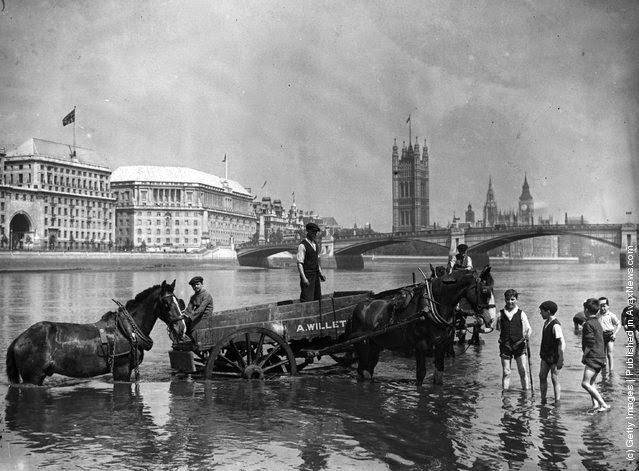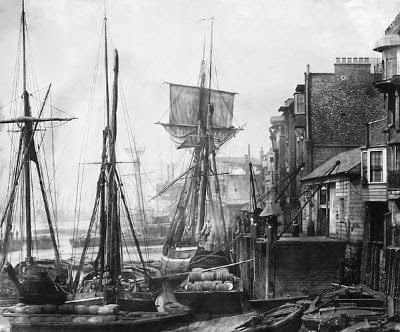You may recall a prior post about mudlarking on the River Thames that I wrote a few years ago – you’ll find it here. I had been longing to return to the River again and was chuffed when Victoria said she’d like to take a turn at mudlarking while we were in London.
Victoria and I started out as part of a London Walks mudlarking tour on Sunday morning, with at least thirty other people in our group. The group was so big that the guide and her assistant broke us up into two groups, while she went back and forth relating the history of the Thames, it’s bridges and, incidentally, mud larking. This went on for quite some time before Victoriasidled up and asked me if we were ever going to get the opportunity to actually get our hands dirty, so to speak. After all, we were almost an hour into the walk and we were still on the northern side of the river.
Finally, we got across the
Thamesand no sooner had we arrived then we lost the tour group. Both tour groups, in fact. The guide had organized us, in two groups, around a set of steps while she told us about something to do with shipping history. Victoria and I had only briefly wandered away and when we turned back, all thirty-something of them had vanished. Considering the size of the two groups, it was uncanny that we could find no sign of any of them. Poof! and they were gone. This did not bode well for our own turns as tour guides in the not too distant future.
“What are we going to do now?” Victoria asked, a tad worried.
“We go mud larking, as planned.”
“But where?”
“Anywhere. There are several sets of stairs on this side of the Thames that lead down the river. If the gate at the top of the steps is unlocked, all we have to do is climb down to the river bank.” I looked over the railings on the Queen’s Walk to the riverbed below. “Look,” I said, pointing at some near distant mud larkers. “They’ve gotten themselves down there, we can, too.”
“Are we allowed? I mean, can we just go down at any point, or is there a designated mud larking spot?”
“Well, no one’s ever stopped me before. If a Peeler with a truncheon comes along and threatens to haul us in as vagrants, we’ll move on. Come on, we’ll go down to the steps that Brooke and I used last time. I know they’re accessible.”
So we walked down to the spot in question and sure enough, the gates were unlocked. Not only that, but there was some sort of Clean Up the River type event going on, so there were several people picking through the sand already. Vicky and I got out our Ziploc bags and climbed down the stairs.
“You want to pick through the stuff at the top here, near the wall and stairs. Everyone typically heads for the waterline first, and they walk right past some good stuff. Here,” I went on, ”take this stick and use it to push the sand aside.” Within minutes, Vicky was mud larking like a pro, searching for blue and white pottery shards and anything else of interest. I found myself a large, flat shell and used that to dig with.
Here’s a photo of me on the River bank, wearing my now famous fur lined boots. Before long, Victoria and I had drifted apart. Her wanderings took her in one direction, mine in another as we both dug through a few decades, if not centuries, of silt and sand.
I love standing on the river bank with the tide out, exposing bits of
Londononly a few people get to see. It’s a way of communing with
London, of getting to the heart of the City I love best. It isn’t glamorous, rather it’s real life at its most rough and ready. At one time, it was home to those who were
London’s poorest – the mud larks who combed this stretch of river bank in search of anything of any value that they could turn into coin for a meal or a bed for the night. Just think of all of their stories, the tales that could be told by people who sailed the river, worked the river, whose lives were tied in some way or another to the eternal rhythm, the ebb and flow of the mighty Thames.
I’ll always remember seeing the opening scenes in one of the Robert Downey Jr. Sherlock Holmes films – the London docks of the 19th century. Never had I seen a movie set that looked so exactly as I had always pictured a place in my mind’s eye. I felt that what I was looking at was 19th century London, magically brought to life on the screen. Imagine my dismay when I later found out that the scenes had actually been shot at Stanley Docks in Liverpool. Here’s a trailer from the film – there’s actually very little of the docks in the clip, but it’s a hoot.
You’ll see from the photos below that it was glorious London day, perfect weather for being outdoors. This is what the riverbank looked like when we were there.
However, this is what I saw in my mind’s eye as I gazed out at the Thames.
Yes, Victoria, I was picturing a place where everyone was wearing period costume. And sailing in period ships.
Back in the 21st century, Victoria and I had a fabulous time collecting treasures from the River. Pottery shards, pipe stems and bowls, animal bones, driftwood, bits of metal and, most surprisingly, shells. We spent not a few hours treasure hunting before I looked up to see Victoriafurther ahead, waving an arm at me in a universal gesture that meant “get over here.”
“We’ve got to wrap things up,” she said when I’d reached her. “We need to eat something and then make our way over to Clarence House.” We’d booked a tour of Clarence House for four o’clock that afternoon, another place we’d always wanted to see, but which is rarely open to the public.
Reluctantly, I agreed but stopped by the station the Clean Up the Thames group had set up nearby. In addition to the sand sculptures below, they had set up a table manned by River historians and archaeologists who were available to a provide insight into the items people had found that day.
I showed them the bones I had found and their best guess was that they had probably come from a dog.
My pottery shards were fairly self explanatory.
The pipe stems and pipe bowl I’d found were a different story. The archaeologists actually had a book with them containing photos of pipes from all periods and going by the shape and size of my pipe, they were able to tell me that mine was early 18th century. The photo above doesn’t do justice to the pipe bowl, it has a very elaborate design carved into the bowl. The expert was much taken with it and told me that it had to have belonged to someone of means. These pipes were meant to be disposable. One bought one already filled with tobacco, smoked it and chucked it away, many times into the River. They weren’t typically the sort of item one spent time carving designs into. He was quite impressed with my find and I was dead chuffed.
Perhaps my most interesting find was this tooth. I’m holding it upside down so that you can see the three rather large roots. The consensus is that it had probably come from a horse.
Victoria’s treasures were much prettier and are pictured above: shells, clay pipe stem, blue-and-white shards, tile pieces.
You’ll find the black and white River photos above and many more period photos of all areas of London and London life on my Pinterest board,
Old London.
More Loose in London Coming Soon!











I find the river to be one of the most evocative places in London. It's the reason the city is there at all, and for centuries it was such a busy thoroughfare. I love your finds!
Another London adventure to put on my list!